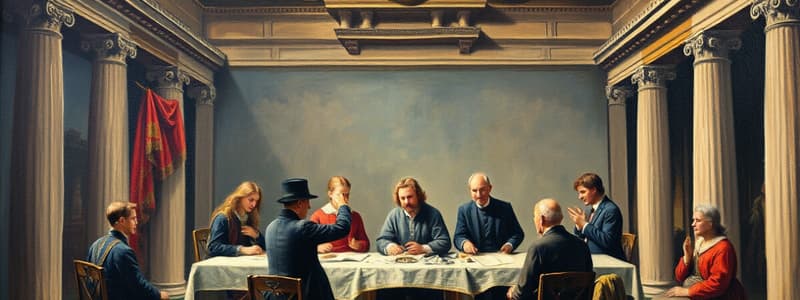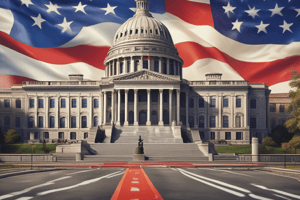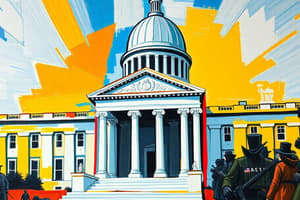Podcast
Questions and Answers
Match the following terms with their descriptions:
Match the following terms with their descriptions:
Supremacy Clause = Term used to denote Article VI of the U.S. Constitution Separation of Powers = The idea of vesting the legislative, judicial, and executive powers of government in separate bodies Power of the Purse = A reference to the ability of legislative bodies to control other branches of government through the control of public money Substantial Federal Question = A requirement for federal courts to hear an appellate case involving a federal legal issue
Match the following types of federalism with their descriptions:
Match the following types of federalism with their descriptions:
Layer Cake Federalism = A metaphor for federalism with separate spheres for federal and state governments Marble Cake Federalism = A metaphor of federalism symbolizing the mixing of powers among governments Cooperative Federalism = A conceptualization of federalism where different levels of government work together Court of Last Resort = The 'highest' court beyond which there is no appeal
Match the following judicial bodies with their levels in the court hierarchy:
Match the following judicial bodies with their levels in the court hierarchy:
Intermediate Court of Appeals = An appellate court between trial courts and the court of last resort United States District Courts = The trial courts of general jurisdiction in the federal court system United States Courts of Appeals = Courts that function as appellate courts for lower federal courts Circuit Courts = The layer of appellate courts situated between district courts and the Supreme Court
Match the following landmark cases with their outcomes:
Match the following landmark cases with their outcomes:
Match the following court types with their functions:
Match the following court types with their functions:
Match the following government concepts with their definitions:
Match the following government concepts with their definitions:
Match the following legal terms with their meanings:
Match the following legal terms with their meanings:
Match the following features of federal courts with their descriptions:
Match the following features of federal courts with their descriptions:
Flashcards are hidden until you start studying
Study Notes
Federal Law vs. State Law
- Article VI of the U.S. Constitution introduces the supremacy clause, asserting federal law's superiority over state law.
Federal Court Structure
- Circuit Courts serve as the federal appellate courts, positioned between federal district (trial) courts and the Supreme Court.
- United States Courts of Appeals act as an appellate court for lower federal courts in each of the 11 federal judicial districts.
- United States District Courts function as the trial courts of general jurisdiction within the federal court system.
- Intermediate Court of Appeals resides between trial courts and the court of last resort, enhancing the judicial hierarchy.
Federalism Concepts
- Cooperative Federalism encourages collaboration among national, state, and local governments to address common issues rather than operating independently.
- Layer Cake Federalism illustrates distinct separations in authority and responsibilities between federal and state governments.
- Marble Cake Federalism represents an integrated approach, symbolizing the intertwining powers and resources of local, state, and federal governments.
Key Legal Terms
- Court of Last Resort refers to the highest court in the system, typically the Supreme Court, beyond which there are no further appeals.
- The Supremacy Clause, found in Article VI, emphasizes the precedence of federal laws over conflicting state laws.
- The concept of Separation of Powers involves the distribution of legislative, judicial, and executive authorities among different government bodies.
Judicial Requirements
- A Substantial Federal Question arises when federal courts can only adjudicate appellate cases involving significant federal legal issues, such as violations of Constitutional rights.
Financial Control in Government
- The Power of the Purse is the legislative ability to influence other government branches through fiscal control and public funding.
Significant Supreme Court Case
- Gibbons v. Ogden (1824) is a landmark Supreme Court case that embraced an expansive interpretation of the supremacy clause, setting a precedent for federal authority over interstate commerce.
Studying That Suits You
Use AI to generate personalized quizzes and flashcards to suit your learning preferences.




